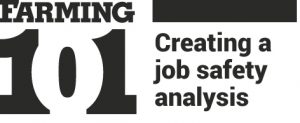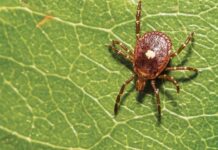Every job has its hazards, but agriculture consistently ranks as one of the most dangerous occupations. One way to improve farm safety for yourself and your employees is to review workplace hazards and potential injuries that could occur.
Creating a job safety analysis or job hazard analysis provides a written protocol for hazardous jobs and tasks and a safe step-by-step way to handle them. An effective analysis identifies hazards and the workers who will be completing a task, provides a basis for training workers, increases safety and awareness, and decreases injuries on the job.

1Select the job
Develop an analysis for all jobs and tasks, but give priority to jobs in which workers have been injured or have a greater risk of injury. When a new job is introduced at your farm, complete a job safety analysis and use the document to train your workers on safe operating procedures.
2Break it down
Break the job or task down into easy-to-follow steps. Identify what is done, not how it is done. Include four to nine steps in the description and make sure steps are not too detailed nor too general. If the task requires more than 10 steps, consider breaking up the task.
If you are not sure how to break down the steps in a specific job, observe a worker performing the job and consult multiple people who are familiar with the job. Ask workers to write out the steps they take to complete a job. Take note of unsafe shortcuts, necessary equipment maintenance and the physical space where the job takes place.
3Identify hazards
As you write out each step, note potential hazards and any actions or conditions in each step of the job that could lead to injury. Is the worker at risk for a slip, trip or fall? Is the worker exposed to fumes or dust? Do the equipment or tools used to complete the job pose any risk of injury? Will there be heavy lifting involved or will the worker be exposed to excessive noise or vibration? Are workers wearing appropriate personal protective equipment (PPE)?
4Develop solutions
Determine ways to eliminate, control or minimize hazards. Modify the process, change the equipment or improve the environmental conditions. If you can’t eliminate the hazard, look for ways to minimize the workers’ exposure to the risk including using enclosures, guards, shields or designated work areas.
Provide a recommended action for each step and state specifically how the step should be completed. For example, phrase a step as follows: “When lifting a box from the floor to the counter, use your leg muscles to accomplish the lift.” Identify PPE, hand signals, and any additional safety recommendations, such as lockout procedures, for each step.
5Evaluate
Evaluate the effectiveness of the analysis after an injury or illness occurs as a result of executing a job or task. Review the causes of injury or illness and make adjustments to the procedure or add additional safety measures. When you introduce new equipment, processes, or materials or make environmental changes, modify or update the job safety analysis. Review any changes to ensure everyone understands.
Sources: Job safety analysis. (2013) Farm and Ranch eXtension in Safety and Health (FReSH) Community of Practice. Retrieved from articles.extension.org/pages/
(Farm and Dairy is featuring a series of “101” columns throughout the year to help young and beginning farmers master farm living. From finances to management to machinery repair and animal care, farmers do it all.)
More Farming 101 columns:
- Tips for a successful lambing season
- Do you have a vision for your farm?
- Cattle handling for beginners
- Should I buy a new or used tractor?
- How to inspect a used tractor before purchase
- How to buy the right tractor for your farm
- 5 tips for a better farm marketing plan
- How to seek help with retirement planning
- How to set goals for retirement
- A farmer’s guide to saving for retirement
- A farmer’s guide to planning for retirement
- 5 steps to get NRCS assistance
- How can conservation easements help you?
- How to fund conservation plans
- What is a conservation plan?
- How can NRCS help you?
- More airborne hazards on the farm
- 5 airborne hazards to beware of on the farm
- 5 things to know about Wagyu beef
- Pennsylvania utility vehicle laws
- Ohio utility vehicle laws
- Farm chemical safety checklist
- When should a farm become a business entity?
- Harvest prep: Check your yield monitors
- How to tag livestock properly
- 6 tips for decision making on a family farm
- 8 tips to prepare your farm for agritourism
- How to plan for farm emergencies
- 7 keys to success on the farm
- 7 tips for healthy fair animals
- 5 tips to ensure livestock health before the fair
- 6 tips to keep your livestock parasite free
- 6 tips for vaccinating your livestock
- 5 tips to prevent dairy cow foot problems
- 6 common foot problems found in dairy cows
- Recognize, prevent heat stress in dairy cattle
- How to monitor your dairy herd
- How to start your own dairy farm
- 5 tips for sun safety in the field
- Employing youth for the summer
- What to do if a hay fire occurs
- How to prevent hay fires
- How to extend the life of your fence
- 10 safety tips for installing electric fences
- How to chose the right fence for your farm
- How to create a fencing plan
- 7 steps for easy sprayer calibration
- Prepare for planting season, Part 2: Calibration
- Prepare for planting season, Part 1: The Basics
- 7 tips to improve security on your farm
- 5 tips to protect your farmland
- 3 measures to deal with severe farm debt
- How to buy time to catch up on farm debt
- 6 tips to manage income on the farm
- 5 tips to recognize and deal with farm stress
- How to prepare a livestock birthing kit
- 5 tips for marketing your farm
- How to develop farm mission, vision statements
- 5 tips for setting farm goals
- 2 types of livestock insurance policies
- 6 things you need to know about WFRP plans
- 3 basics of crop insurance
- How does liability insurance work on the farm?
- Why do I need farm insurance?
- How to understand and use Ohio’s CAUV
- How to utilize the Pa. Clean and Green Act
- 9 tips for filing farm taxes
- 8 reasons record keeping for taxes is essential
- 5 tips for post-harvest storage
- 7 tips for family meetings on the farm
- 4 tips for balancing your farm and family
- 4 tips for communicating on the family farm
- 4 tips for firing an employee
- 6 tips for keeping good farm help
- 4 tips for recruiting farm labor
- 5 general farm labor laws
- 4 tips for employing minors
- 4 tips for PTO safety
- 5 things young farmers should know about finances
- The farm balance sheet
- 5 items for your farm’s cash flow statement
- Personal and business records: Keep them separate
- What to include in your farm business plan
- How to approach a lender: Tips for getting a farm loan
- How to use microloans to get your farm started
- Saving for the future: 6 tips for young farmers
- How to create a farm safety kit
- 5 tips for child safety on the farm
- 4 tips for transporting livestock
- 5 ways to better understand tractor stability
- 6 farm equipment hacks












